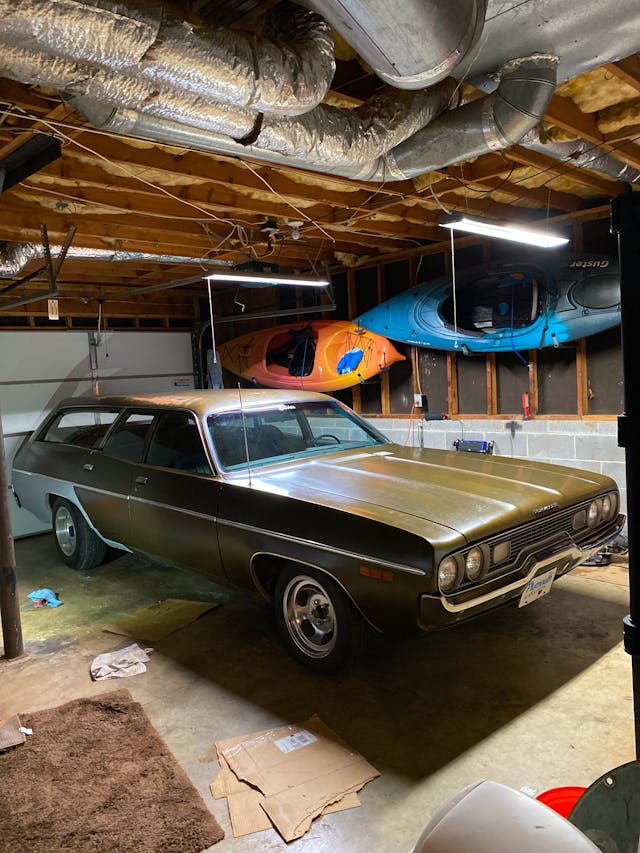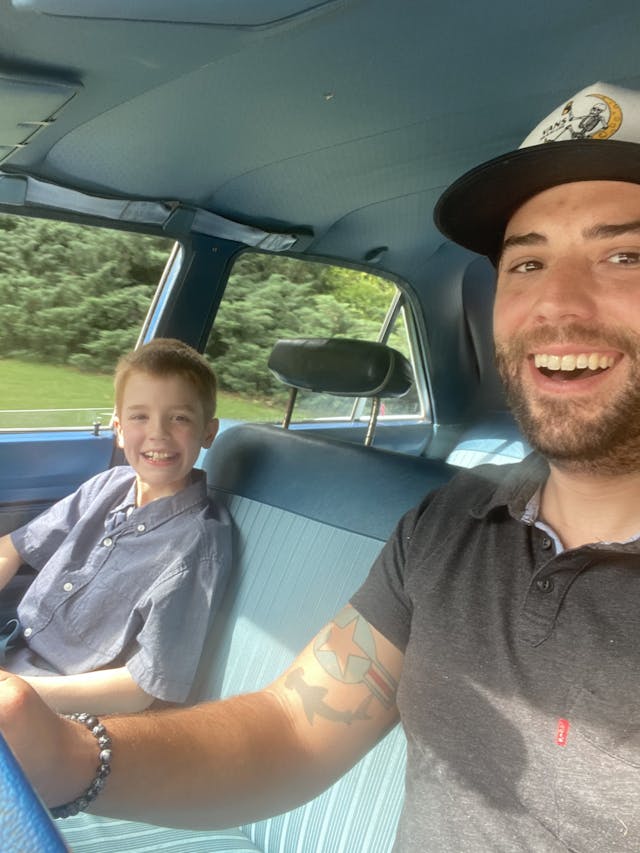A Marine mechanic returns from “the sandbox” and brings his son into the ’70s

“What’s a kid like you doing with a car like this?” the truck driver inquired when I arrived to meet him. He was unloading a handful of cars from his flat-bed. On the hook sat a Ford Fusion with bullet holes in the passenger door, a tired Hyundai Sonata, and a 1971 Plymouth Satellite Station Wagon. Being on the far side of 30 I can tell you that I don’t mind the rare occasions when I’m called a kid. On the other hand, when it comes to cars I sometimes feel I was born too late, and that’s the answer I gave.
“I could tell you were younger over the phone. I was just wondering why you would be interested in this car, and not a newer Charger or Challenger or something,” said the man hauling my new old longroof. To be fair, I have no qualms with modern Mopars. I’ve even owned a few.
“I like things that nobody else has,” I explained, “and for as long as I have scoured the Internet, I can say with a certain confidence that there aren’t too many people out here driving these cars anymore.” This Plymouth wagon wasn’t my first time acquiring a vehicle produced in the 1970s. Nor was it the second, or even the third time. I’ve had more vehicles produced in the decades preceding my conception than I have from my own era.

This particular car had just been trucked into Georgia from the small town of Burlington, Kansas. A dear friend of mine had called me to let me know he was retiring from the classic car business, and that he was getting rid of everything that would move. Closing his doors for good. This meant sweetheart deals on ancient metal. There’s a finite list of individuals who are capable of restoring or rebuilding these cars as well as he did, and there are even fewer people in my age group who share this same obscure interest in them. The list gets shorter every year. They’re something of a dying breed. It’s a thought that scares the actual hell out of me.

The majority of my friends and acquaintances in this business have about 20 years on me. The individuals I trust the most are older still. They have spent the better parts of their lives underneath the hood or behind the wheel of these vehicles, learning every specific nuance and detail of proper care, maintenance procedures, and the best tuning strategies for obsolete engines while most of the “kids” in my generation (myself included) grew up on video games and computers in the age of dial-up internet.
My dad always kept cool stuff around, though. My childhood was split between time in the garage and bouts of Golden Eye. I learned the basics. I knew what the components were and what they were for, but looking back I didn’t really have the amount of interest I should’ve. By the time I was in high school he was competing in the pony stock class at most of the dirt tracks in our corner of Georgia.

It was exciting. The lights and the smell of race fuel mixed with the red clay in the air when late models ripped around. I’d sneak a Pabst Blue Ribbon out of the cooler when he took to the track. Then we’d bring it all home at midnight beat up or broken to unload and start over. A perpetual anxiety soaked us ahead of the next Saturday night.

After I graduated, I joined the Marines. All of a sudden, I didn’t have much time for cars anymore. I bounced around the country and in and out of the sandbox, fixing combat helicopters. Fast-forward to later in my 20s and I bought my first Mopar; a 1971 Dodge Dart. It was New Years’ Day 2014. I had a wicked hangover, a wad of hundred-dollar bills, and the number for a local tow truck. After a brief negotiation the car was retrieved, and for the next three years I jerry-rigged that car to the brink of sacrilege. I was grateful for the body being mostly intact and rust-free, because that’s essentially the only thing that wasn’t traded off for something different, lighter, faster, or better. The end result was a Dart Sedan fitted with a 318 making more power than many would ever suspect.
A five-speed transmission came from a newer Ram 1500, and it gave me overdrive. A K-member was transplanted from a later model Valiant which provided for power steering and the single-piston disc brakes let me stop with confidence. The suspension was rebuilt, torsion bars and leaf springs upgraded, and then I replaced most of the interior. When finished it hauled wholesale ass and cornered like a modern compact. The most important thing to me was that there wasn’t another Dart or Valiant sedan like it anywhere.
I tell you all of this to explain that throughout that single car building experience I learned more than I could probably explain in one sitting. I started the project absolutely clueless. To get this done I needed a LOT of help, and there were several people involved. I knew what I wanted the car to do, but I didn’t have a single sound idea on how to get it there, or how much I would be overcharged for things in the process. For everything I learned on this project, six years ago now, and the several cars I’ve cycled through since, there is still an actual abyss of information and knowhow that I wouldn’t completely pick up if I built another 20 cars the same way.

I’m doing my best to retain information whenever it is volunteered by the veteran builders and restorers I know. Still, there is so much more to learn. Every shop that shuts down, or contact who retires is another book closing. There will always be shop manuals and forums, but those isn’t nearly as exciting as Brad from Kansas who can translate an entire fender tag from memory without having to reference any literature. Or Bobby from my neck of the woods who can rattle off exact specifications on flow, valve dimension, and exactly how to wring out every last bit of power from any set of Mopar heads you can list.
They’ve spent 40+ years (each) tinkering, racing, breaking, losing, learning, rebuilding, reimagining, and most of all loving these cars. Their experience is immense. Yet for them retirement isn’t just a prospect anymore. I find myself wondering what is going to happen to this generation of classics in the hands of people like me who probably played too many video games when they could’ve been developing calluses, busting knuckles, or packing grease in fingernails. The best I can do is hang around long enough to learn anything I can from them while they’re still producing. At the same time, I want to find a way to engage whomever will listen.

My son will be 12 soon, and he’s already showing interest in all the things I get excited about. I know he would much rather hear a big V-8 start up and carry us to our destination over the air-conditioned comfort of the practical daily driver in the driveway. Nothing compares to the smile on his face when the secondaries open and push him further into his seat. I have countless pictures of him standing next to rare examples of classic muscle from nearly half a century ago with the same smile on his face. Maybe these things will inspire him to choose something similar when he’s of age.
Maybe one day he’ll get the same question from a truck driver delivering his newest toy.

